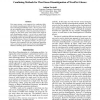Free Online Productivity Tools
i2Speak
i2Symbol
i2OCR
iTex2Img
iWeb2Print
iWeb2Shot
i2Type
iPdf2Split
iPdf2Merge
i2Bopomofo
i2Arabic
i2Style
i2Image
i2PDF
iLatex2Rtf
Sci2ools
101
Voted
FLAIRS
2004
2004
Combining Methods for Word Sense Disambiguation of WordNet Glosses
This paper presents a new approach for combining different semantic disambiguation methods that are part of a Word Sense Disambiguation(WSD) system. The way these methods are combined greatly influences the overall system performance. The approach is based on generating training examples, for each sense of the word, based on the output of each disambiguation method. A set of rules is learned from the training examples and then applied to optimize the output of the WSD system. We tested this approach on disambiguating WordNet glosses. However the approach is applicable to any WSD system. Our approach yielded a 3% gain in performance when compared with more traditional approaches such as selecting the sense given by the best disambiguation method or summing up the contribution of each method.
Related Content
| Added | 30 Oct 2010 |
| Updated | 30 Oct 2010 |
| Type | Conference |
| Year | 2004 |
| Where | FLAIRS |
| Authors | Adrian Novischi |
Comments (0)

